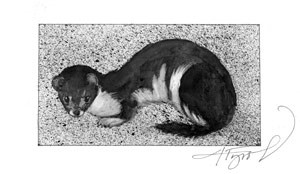
The tumbledown stonewalls that flank many a wooded road in New Hampshire and Vermont stand as picturesque reminders of former pastures and times gone by. They also have an ongoing function. Their nooks and crevices are homes and hiding places for numerous creatures, from spiders and snakes to small mammals. One fall I glimpsed a small face peering between wall stones, and at first I thought it a squirrel. Yet it was strangely piebald in brown and white. Not a squirrel at all, but a weasel, changing from its summer coat to its winter coat. Later, in winter, I would see weasel tracks in the snow along the wall.
Two weasel species, the long-tailed and short-tailed weasel, live in our area. The two species differ in size, the long-tailed being larger, 11-22 inches versus 7-13 inches. (These measurements include the length of the tail, which is 40 to 70 percent of the head and body length.) Of course, there is some overlap, because male weasels are considerably larger than females.
In regions of snow, both species change their coat from summer brown to winter white. The white hair, which is longer and denser, replaces the brown over a period of three to five weeks. The color change starts from the belly and spreads upward. In spring, the process is reversed. Only the tip of the tail, which is black, remains unchanged. Interestingly, the ability to change color is genetically programmed. Weasels from the south do not change color even when they are transplanted to the snowy north. Likewise, northern weasels still turn white when moved to a southern climate.
The change in color is triggered by length of daylight, not by temperature. That means weasels face special risks during any winter of on-again, off-again snow. Northern weasels can’t help but turn white even when the earth remains brown – which makes them easy targets for predators.
Historically, the skins of weasels in winter pelage were highly prized. Their fur is known as ermine (as is the animal itself in its winter whites), and in ages past it symbolized purity and innocence. According to medieval lore, the weasel would risk death to avoid soiling this beautiful coat. All a hunter needed to do was smear a weasel’s lair with mud while the animal was out. According to the theory, the exhausted weasel would surrender before running through mud. The weasel in white thus came to symbolize noble notions of “death before dishonor,” and its fur began adorning the ceremonial attire of monarchs. As recently as 1937, a total of 50,000 ermine pelts were sent from Canada to England to make robes for the coronation of King George VI.
More appropriately the weasel should symbolize courage. These small carnivores, weighing between two and 12 ounces, are muscular, ferocious and fearless, and often they will attack larger animals. Highly curious, they constantly move about to explore for food. They are agile climbers and can swim, and their long thin bodies and short legs help them pursue rodents in burrows. In fact, female long-tailed weasels hunt mainly underground, while the males, being larger, tend to hunt above ground. This division may allow males and females to coexist without competing for food.
Their prey is chiefly mice and voles, so the presence of weasels usually indicates a substantial population of these rodents. Those who spot and follow the tracks of a small rodent in snow may encounter those of a weasel. I once tracked a mouse near the Ompompanoosuc River in Thetford, Vt., where I live. Eventually its patch intersected with the bounding tracks of a weasel. After that only weasel’s tracks were apparent—as it had carried off its next meal.
Weasels have a bloodthirsty reputation. Their “killing sprees,” however, should be viewed as an important survival strategy. They are active, sometimes covering three miles in a day in search of food. Due to their elongated bodies and lack of fat, they do not retain heat effectively. They keep warm by eating at least 40 percent of their weight in food daily. Surplus kill is often stored in a side chamber (a vacated rodent borrow) of the weasel’s den as ‘insurance’ against unlucky hunting times.
Predators hunt, and they are hunted. The weasel’s natural enemies are owls, hawks and foxes. And this is where their black tail tips enter the picture. In experiments, hawks presented with a stuffed weasel without the black tail tip easily identified it as vulnerable prey and struck at the weasel’s head. However, when the stuffed weasel had a black tail tip, hawks often hesitated until finally attacking the tail. The black detail, a blotch on ermine purity, gives the fighting critter a fighting chance.


Discussion *